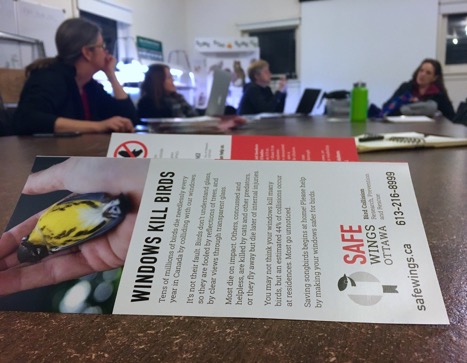Ottawa’s bird friendly guidelines take flight
By Crystal Oag
The City of Ottawa is drafting new guidelines to push developers towards addressing the hundreds of thousands of birds dying each year from window collisions. The goal is to offer information on different bird-safe design practices to reduce fatalities.
“It’s about time,” said Anouk Hoedeman, coordinator of Safe Wings Ottawa, a bird-safety organization that studies bird collisions and releases annual data.
According to the latest data from the Safe Wings, an estimated one billion birds are killed across North America each year from window collisions, with an estimated 250,000 such deaths in Ottawa alone.
Melissa Jort-Conway, a planner with the City of Ottawa, is the project manager for the bird-friendly guidelines. She said Ottawa began drafting the guidelines in January and is working to implement them by 2019.
Jort-Conway said Ottawa will draft the guidelines based on best practices from Toronto, Vancouver and other cities across North America.
Bird-friendly development guidelines in other cities advocate such measures as installing visual markers on windows and reducing light pollution through design.
According to the Safe Wings website, collisions happen primarily because birds confuse reflections in windows with trees or attempt to fly through the clear glass. Visual markers and bird-safe design can prevent this confusion.
Hoedeman is on the working group developing the guidelines. The most effective solution for bird collisions, she said, is to reduce the number of windows on buildings altogether.
Michael Mesure, the co-founder of Toronto’s Fatal Light Awareness Program — the first organization to focus on studying bird collisions, beginning in 1993 — said if Ottawa’s guidelines are similar to Toronto’s, they will only apply to new construction.
“We have all this wonderful progress taking place with new construction,” said Mesure. “The fact of the matter is, well over 90 per cent of buildings are existing construction. These are the ones that are posing the greatest threat.”
Hoedeman said Ottawa faces the same problem.
“In Centretown, mostly it is existing buildings that we are seeing as the biggest problem,” she said.
In 2016, more than 30 bohemian waxwings were killed when they slammed into Ottawa’s glassy City Hall between Laurier and Lisgar streets. The incident prompted national news coverage.
If Ottawa’s guidelines mimic Toronto’s, they will not apply to residential areas.
“An individual home may only be killing a handful of birds a year, but there are so many homes out there that those numbers really add up quickly,” Hoedeman said.
The Safe Wings Ottawa website says it only finds about five to 10 per cent of birds killed by collisions in actively monitored areas, including Centretown. Many of the undocumented collisions take place in residential neighbourhoods, said Hoedeman.
“We need standards in place for existing construction,” said Mesure, “and that is a much bigger battle, because homes represent the greater threat to bird collisions during the day, and forcing individual homeowners to retrofit their windows is very difficult.”
Bob Volks, owner of Little Italy’s Gilligallou Bird store, said residents are generally unaware of the true impacts of bird collisions. His Preston Street shop sells window decals and other bird-safety products, and said many people don’t install them because they worry it will affect the look of their homes.
“There is not as much emphasis put on the bird,” said Volks. “What if it was you that was smacking into the window? Because it is the same thing. We are the same as the bird.”
Hoedeman said the biggest challenge in combatting window collisions is lack of awareness. She said she does not know how effective the guidelines will be at reducing collisions, but they should be useful in spreading the word.
“Just the fact that there will be guidelines out there goes a long way to educating people about the problem and about the solutions,” said Hoedeman.

